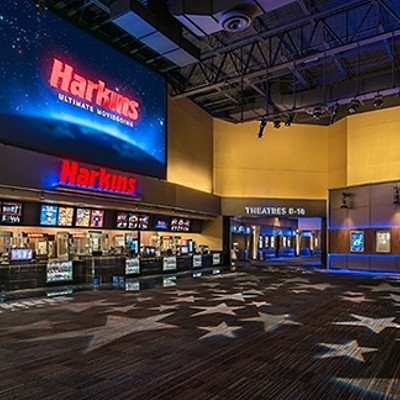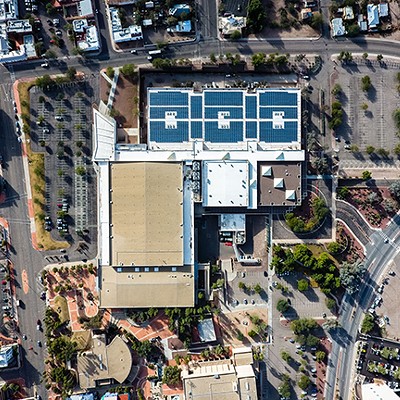"What's strange is that they are building half-million-dollar homes in this neighborhood," Villaseñor says while glancing down his street toward the mixed-use development being constructed on Tucson's westside as part of Rio Nuevo. "I just wonder if they're going to be able to sell them. Are people who can afford it going to want to live here?"
Villaseñor is not knocking his neighborhood--he loves it and has lived there for 55 years. He's just curious to find out how the high-end development will mesh with the working-class neighborhood in which he grew up.
Located just west of downtown, the Menlo Park neighborhood was formally created in the 1920s, although the area is considered the birthplace of Tucson and has a history dating back thousands of years.
The new development, called the Mercado District of Menlo Park, is being constructed on land just south of Congress Street. The site was first inhabited more than 2,500 years ago, and the streets will follow an ancient canal system, according to the development's Web site. The area was also home to Spanish colonists, and a compound was built on the site in the 1700s.
The design emphasizes creative architecture to maximize space and aims to be pedestrian-friendly with courtyards, plazas and walkways. It will be connected to the surrounding area by a modern street-car system that will go through downtown, up Fourth Avenue and east on University Boulevard.
The project looks great on paper, but there are some concerns that the recent slowdown in the housing market, along with the subprime mortgage crisis, could have a negative effect on construction. However, Tom Wuelpern, the president of Rammed Earth Development, one of the developers building homes in the Mercado District, says he does not believe the crunch will negatively impact the development.
"All of our buyers are very stable, and I do not feel the mortgage crisis is affecting us or them at all," he said, adding that while tract subdivisions may have elevated prices during the heated market, the developers of the Mercado District did not.
One thing is for sure: The ambitious project will dramatically change the surrounding neighborhood.
Sandra Garcia grew up in the area, just on the other side of Sentinel Peak, and has been living in Menlo Park for 12 years. She loves the serenity of the neighborhood and the fact that families stay in the area for generations. She compared the neighborhood to a family.
Sitting in her living room surrounded by sympathy cards--her mother recently passed away--she recalls the rich history of the neighborhood and nearby downtown.
"Downtown was neat; it was beautiful when I was a kid," she said. "It was the place to be, they had wonderful, wonderful and elegant stores, but all that's gone."
Making downtown Tucson relevant again is the ultimate goal of the Rio Nuevo project, and Garcia thinks the Mercado District is a step in the right direction.
"I think it'll be nice; a lot of people can visit it. There are going to be little mercados and stores there, little bakeries and things like that. It's going to be a nice place to visit."
Not everyone agrees. Villaseñor thinks the development may leave the old neighborhood on the outside looking in.
"I see it, potentially, as two separate communities," he said. "There will be this little elitist community in the middle of all us working-class Joes. I would hope it doesn't turn out that way, but that's just the way I see it."
According to the real estate Web site zillow.com, the median value of a home in the existing Menlo Park neighborhood is $156,500, while the homes already constructed in the Mercado District range in price from $400,000 to $750,000.
Gene Einfrank, one of the pioneer residents of the new development, doesn't disagree with Villasenor's assertion that there are going to be differences between residents of the development and the old neighborhood.
"There's an economic divide, pure and simple. You have that in many, many cities. But I think it's all in how the community deals with it, how the community finds their similarities," Einfrank said. "There's a lot to be said about diversity, not just cultural, or from a religious standpoint, but also economic diversity.
"There are people who have much more money than we do--we're middle-class--and there are people who have much less money, but when I look at people, it's really their character. ... I think it has to do with how neighbors interact with each other, and hopefully we can get involved in the neighborhood association here and get to know our council member, and get to know everybody."
Einfrank--sitting in his courtyard with water running down a large outdoor fountain as a breeze blows through wind chimes above his head--expresses nothing but satisfaction over his decision to move into a development that is still more a dream than reality at this point.
With a new house that runs on solar power and no backyard to water, he is pleased that his family is leaving a smaller footprint on the environment than they did at their previous home in the Sam Hughes neighborhood. He also expresses optimism that once more people move in, and everyone starts interacting on a daily basis, Menlo Park, old and new, will become one neighborhood.
"I think the surrounding neighborhood is charming. I accept my neighbors. I accept the diversity of the area, and I hope they accept us."












